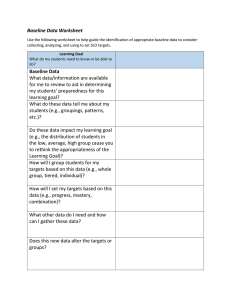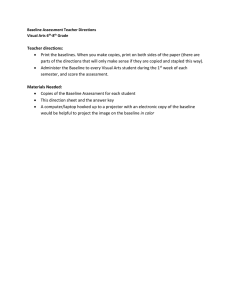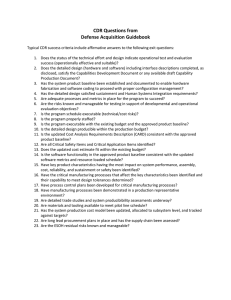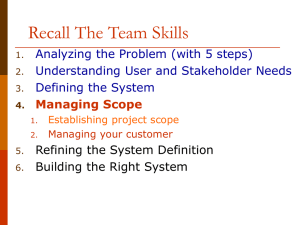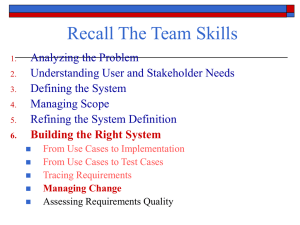Recall The Team Skills Analyzing the Problem (with 5 steps)
advertisement
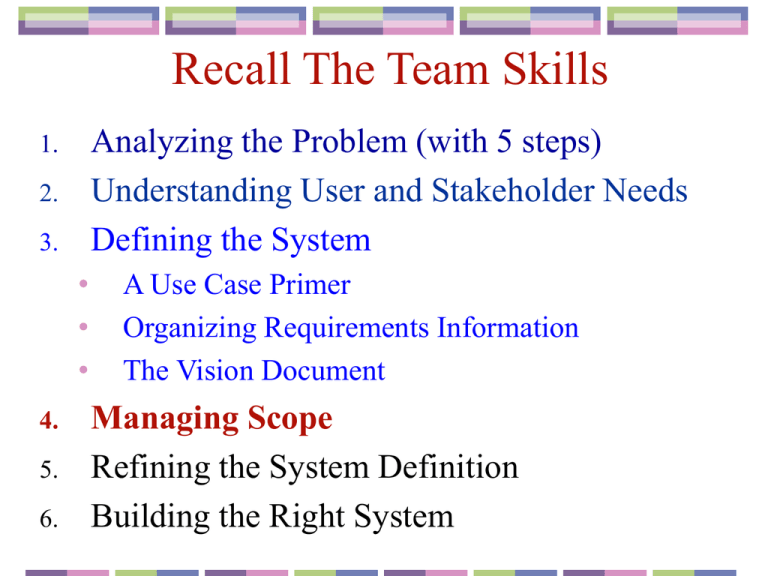
Recall The Team Skills Analyzing the Problem (with 5 steps) Understanding User and Stakeholder Needs Defining the System 1. 2. 3. • • • 4. 5. 6. A Use Case Primer Organizing Requirements Information The Vision Document Managing Scope Refining the System Definition Building the Right System Team Skill 4: Managing scope Ch 18: Establishing project scope Ch 19: Managing your customer Chapter 18 Establishing Project Scope Project scope problem The Requirements Baseline Setting Priorities Assessing Effort Adding the Risk Element Reducing Scope The Problem of Project Scope Project scope (complexity) depends on: • The functionality that has to meet the user's needs • The resources available to the project • The time available for the implementation Project scope derives from the following elements. • Resources consisting of the labor: developers, testers, tech writers, quality assurance personnel, and others. • Time is perhaps a "soft" boundary that is subject to change if the available resources are inadequate to achieve the desired functionality. The Problem of Project Scope If the effort required to implement the system features is equal to the resources available during the scheduled time, the project has an achievable scope, and we have no problem. But what if not ...? The Problem of Project Scope What happens when a project proceeds with a 200% initial scope? If the intended features of the application were completely independent, which is unlikely, only half of them will be working when the deadline passes. If some of the application features do depend on others, at deadline time nothing useful will work. The Problem of Project Scope What happens to software quality during either of these outcomes? The code, which is rushed to completion near the end, is poorly designed and bug-ridden; testing is reduced to an absolute minimum or skipped entirely; and documentation and help systems are eliminated. The Hard Question The hard question: How does one manage to reduce scope and keep the customers happy? Brooks' law states that adding labor to a late software project makes it even later. We need another way to solve the scope problem Solution: If we truly begin the development effort with an expectation of 200% scope, it will be necessary to reduce the project scope by as much as a factor of two in order to have any chance of success. ... But how? Solution: Managing scope Feature 1 Feature 2 to be implemented Feature 3 .. -------------- Requirement baseline -----------... Feature 4 Feature 5 to be postponed for future Feature 6 The Requirements Baseline The requirements baseline is the itemized set of features intended to be delivered in a specific version of the application. The baseline must … • Be at least "acceptable" to the customer • Have a reasonable probability of success, in the team's view How do we define it? Setting Priorities During prioritization, it is important that the customers and users, product managers, or other representatives — not the development team — set the initial priorities. Assessing Required Effort The next step is to establish the rough level of effort implied by each feature of the proposed baseline. The best we can do is to determine a "rough order of magnitude" (High, Medium, Low) of the level of required effort for each feature. Why? • Little useful information is available yet on which to estimate the work • No detailed requirements or design output on which to base an estimate. Adding the Risk Element The Risk associated with each feature is the probability that the implementation of a feature will cause an adverse impact on the schedule and/or the budget. A high-risk feature has the potential to impact the project negatively, even if all other features can be accomplished within the allotted time. The development team establishes risk based on any heuristic it is comfortable with, using the same low-medium-high scale used to assess effort Example: Prioritized Features List with Effort and Risk Estimates Reducing Scope Scope Prioritization Techniques Example: Final Prioritized Features List Features below the baseline are now future features and will be considered in later releases. Making the cut Is it enough to do all critical features? Can we include some important ones? Are there any dependent features? Useful usually can be cut out. Many possible future cuts. Cuts can be changed as project progress. Reading Assignment Read the scope management for HOLIS in pages 218-222. Key Points Project scope is a combination of product functionality, project resources, and available time. Brooks' law states that adding labor to a late software project makes it even later. If the effort required to implement the system features is equal to the resources available during the scheduled time, the project has an achievable scope. Over scoped projects are typical. In many projects, it will be necessary to reduce the scope by as much as a factor of two. The first step in establishing project scope is to establish a high-level requirements baseline.
